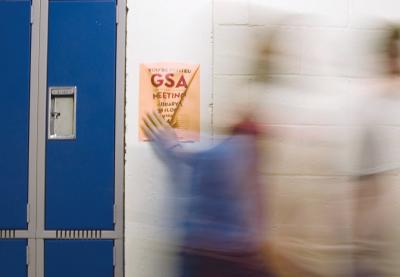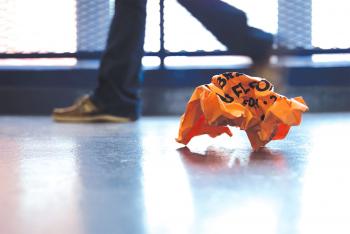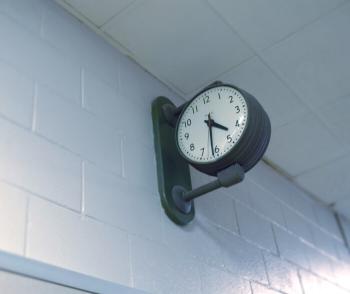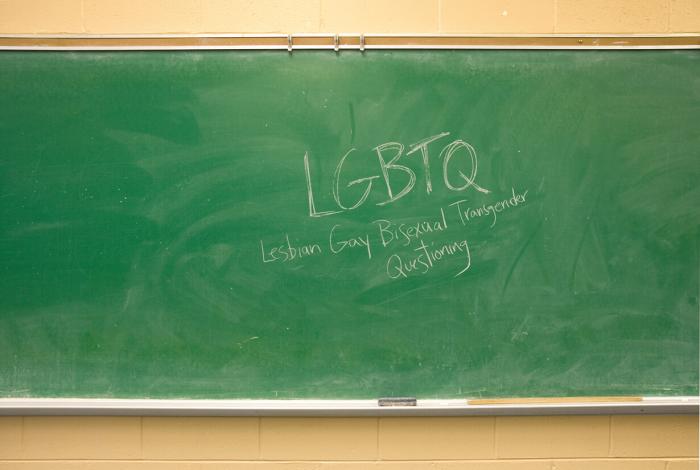For several weeks last spring, fliers announcing Sennett Middle School's Gay-Straight Alliance were torn from the hallways, revealing a hidden message to the culprits about why the club was important in the first place. Safe spaces can be hard to come by when you're a middle school student, especially if you're lesbian, gay, bisexual or transgender. For the past 10 years, GSAs have helped high school students fight anti-gay harassment. Experts say middle school is where GSAs might be needed most -- and their numbers are starting to grow.
Harassment.
Name-calling.
Physical assault.
Getting slammed into lockers. Taunted in the hallways. Tormented in the bathrooms.
For LGBT teens, school can be a battleground.
In fact, LGBT students, as well as students perceived by peers to be gay, are the most common targets of harassment at school. That harassment can reach its most fevered pitch in middle school.
Every two years, the Gay, Lesbian and Straight Education Network, or GLSEN, gauges the treatment of LGTB students in its National Campus Climate Survey. In 2005, 64 percent of middle school students reported anti-gay bullying and name-calling as major problems in their schools -- 18 percentage points higher than what was reported by high school students.
"There is something about the name-calling environment in junior high and middle school that is particularly prevalent, and it makes middle school an important focus for behavioral change," says Eliza Byard, GLSEN's deputy director.
Anti-gay harassment has prompted the widespread growth of gay-straight alliances. Commonly called GSAs, these student-run clubs create safe spaces for gay youth and their allies; most clubs also organize campuswide events to increase the acceptance of marginalized groups and reduce anti-gay bullying.
High school GSAs have existed for more than a decade; at the end of 2005-2006 school year, more than 3,000 GSAs were listed on GLSEN's high school roster. Middle school GSAs are less common, but they're growing. Three years ago, there were fewer than two dozen middle school GSAs. Today, at least 500 exist -- serving one out of every 20 middle and junior high schools nationwide. The growth can be attributed, in part, to younger students learning about GSAs from high school siblings, the prevalence of the Internet, and the fact that in general, students feel more comfortable discussing issues of sexual orientation at an earlier age than in generations past.
In Madison, Wis., active GSAs exist or are being launched in 10 of the city's 11 middle schools. That's the highest per capita concentration of middle school GSAs in the nation, and it's starting to reduce the jokes and bullying -- mostly subtle, but sometimes not-so-subtle -- faced by LGBT teens.
Safe Spaces
At the back of the counselors' maze of offices at Madison's Hamilton Middle School, a wall divider carves out just enough space for a folding table. It's a quiet pocket of an otherwise-bustling school -- until 2:45 every Tuesday afternoon.
Amber and Chad, two 7th-grade girls, arrive first, wearing black T-shirts and thick, black eye liner.
Next is Nina, a tall 8th-grader who takes dance classes on the weekends and who, once the meeting has started, will be the first to raise her hand when the club's adviser asks a question.
Then Zou Zou, an 8th-grader who seems shy at first, until she starts talking about the cello, and then she beams. Next comes Brandon, a 7th-grader, small for his age, whose personality can fill a room. And last there's Nick, a wiry 6th-grader who loves soccer and joined the GSA so he'd have a safe place to talk about his two dads.
A few members are absent, but the GSA meeting starts anyway.
"Let's talk about the Day of Silence," says Jane Biondi, a Hamilton counselor and the group's faculty adviser. Every April, students across the country go through a day without speaking, often wearing rainbow ribbons or black armbands, in recognition of the daily harassment faced by LGBT students. At Hamilton, almost half of all students participated.
GSA members discuss their successes ("A lot more people did it than I expected," Nina says), and some of the challenges to remember next year ("I heard that some of the 6th-graders only did it so they wouldn't have to be called on in class," says Chad).
Hamilton's was the first middle school GSA in Wisconsin. It started in the fall of 2002, when a 7th-grader asked Biondi if she would act as the club's sponsor.
Like most GSAs, this one is part social, part support, part leadership development.
"My stepmom said we're too young to know our sexuality," says Chad.
Her comment prompts a round of groans, eye-rolling and head-shaking.
"We're not too young to know how we feel," says Nina. "It doesn't take a certain age to know yourself."
Biondi has written a string of letters on the chalkboard: LGBTQ. "The 'Q' stands for 'questioning,'" Nina says. "I think Q is a safe place to be at our age."
Zou Zou nods her head. "Around our age, we all go through this stage of sort of questioning ourselves and not feeling very secure. Sexual orientation is a big part of that," she says. "Sometimes parents can use our age against us, like, 'Oh, it's just a phase.'"
"I knew I was gay when I was 4," interjects Brandon. "I just … knew."
Harassment in the Hallways
Madison is the state capital, the state's second-largest city, and home to the University of Wisconsin-Madison, ranked one of the most activist-leaning universities in the country. In 2000, the city became one of only 83 local jurisdictions in the country to prohibit discrimination based on gender identity.
But that's just part of the picture.
"You'll find just as much prejudice here as in any other city," says Bonnie Augusta, the LGBT resource teacher for the Madison school district. "You scratch our progressive surface, and we bleed."
Students in Madison's middle schools say anti-gay slurs are the most widely used put-downs in hallways and classrooms. And several teachers confirmed GSA members' common objection that teachers don't seem to reprimand anti-gay language as often as remarks targeting students' race, religion or ethnicity.
But research findings are creating a wake-up call, prompting school administrators to pay closer attention to anti-gay harassment.
GLSEN's December 2003 National School Climate Survey, for example, revealed a direct link between at-school harassment and the declining grade-point averages and college aspirations of LGBTQ students.
"It's really simple: If you don't feel safe at school, you can't learn -- you're thinking about the next insult, the next throw against the locker," says Brian Juchems, program director for GSAs for Safe Schools. Based in Madison, the group provides leadership development and technical assistance to GSAs across south-central Wisconsin.
In June 2004, GLSEN surveyed state policies to determine how well states were protecting LGBTQ students from harassment. Arranged report card-style, the survey assigned each state a grade: 42 states received F's, and only two received an A.
Alarmingly, only eight states prohibited harassment based on sexual orientation, and seven states criminalized any positive mention of LGBT issues or people in the classroom.
Wisconsin's survey grade was a C; only five states scored higher.
"We're doing a lot more right than we're doing wrong," Juchems says.
The vocal support for GSAs from principals and other administrators here makes a huge difference, setting Madison apart from many cities.
"It shows that the school district is dedicated to making sure these issues get addressed," Juchems says. "…When I find school districts that are so opposed to GSAs, I'm like, 'This could be the one place students feel safe, or the one thing that keeps them in school.'"
It's really simple: if you don't feel safe at school, you can't learn—you're thinking about the next insult, the next throw against the locker.
Report Card
School safety for LGBTQ students:
New Jersey A (95%)
Minnesota A (91% )
Washington, D.C. B (89%)
Vermont B (82%) California B (80.5%)
Wisconsin C (73%)
Massachusetts C (70%)
Rhode Island D (65%)
All Other States F (ranging from Maryland's 56% to Mississippi's -3%)
Source: 2004 GLSEN Survey • Criteria: GLSEN's grading scale was based on six categories: the existence of statewide "safe schools" laws; statewide non-discrimination laws; support for education on sexual health and sexuality; local "safe schools" policies; general education issues (e.g. student/teacher ratios, graduation rates); and the existence of laws that stigmatize LGBTQ people.
Safer Schools
Last year, members of Hamilton's GSA decided they were fed up with anti-gay remarks in the hallways. With the help of a grant from the school district, they designed classroom posters that read, "I just heard you say 'That's so gay.' What I think you meant was. . .", followed by a long list of adjectives, like ridiculous, silly, absurd and foolish.
They gave a poster to every teacher in school. After the posters went up, students say, the "that's so gay" language went down.
"Someone in my class said, 'That's so gay,'" Brandon, a 7th-grader, remembers. "I said, 'That's not OK to say,' so he looked at the poster and said, 'I mean, that's so ludicrous.'"
Across town at Sennett Middle School, gay students were teased for buying carnations during the annual Valentine's Day sale. After discussing the pros and cons, students decided to form a GSA, and Spanish teacher Rebecca Wennlund agreed to be the group's adviser.
Fliers announcing GSA meetings at Sennett often get torn down, so Wennlund decided to get creative. Underneath each meeting announcement, she tapes another sign, revealed only when the first flier gets ripped off. It reads, "Stop! THIS is why we need a GSA!"
"In the beginning, kids would say, 'Oh, so-and-so needs to join the GSA,' as a way to tease or ridicule," Wennlund says. "We still have harassment, but it exists to a lesser degree."
Responding to Critics
GSAs can meet with controversy. In severe cases, school districts have decided to ban all extracurricular clubs to avoid permitting GSAs. Sometimes, the battles go to court, as in the case of a White County, Ga., high school that terminated all student organizations after students tried to start a GSA. In July 2006, a U.S. District Court ruled that the high school's action violated the federal Equal Access Act, in a major victory for LGBT students and teacher allies in Georgia and across the country.
While no one has challenged Madison's GSAs in court, several parents and some teachers have voiced resistance. Parents worry the clubs "teach" kids to be gay and encourage sexual behavior at an early age. Teachers are concerned a GSA might incite angry protests from parents.
That GSAs are about sex is a common misconception, says Juchems, from GSAs for Safe Schools.
"When adults say that, we say, 'Actually, you're confusing sexual activity with sexual orientation,'" he says. "You can talk about feelings and identity without talking about the mechanics of sex."
A January 2004 article in the Wisconsin State Journal publicized the growth of Madison's middle school GSAs. A barrage of letters to the editor followed, many criticizing such activity in middle schools as inappropriate and immoral.
Biondi, the adviser at Hamilton Middle, showed the letters to her students. "We discussed it," she says. "I wanted them to be able to decide for themselves whether they think those are valid arguments."
To depoliticize the issue, Byard, from GLSEN, encourages teachers and parents to think about GSAs in the context of First Amendment rights and school safety.
"We are focused on behaviors that are appropriate for schools, not on the beliefs of people who attend those schools," Byard says. "There have to be ways to co-exist within those environments, even if we have differing views on the world."
Selma's Story
It's a little after 4 o'clock, and Selma Anderson just got home from school. She and her twin sister Kezban jostle for space on the couch. The dog wants out. They have homework to do, but they'll do it later. Right now, their mom wants to know what happened today at school. Selma and Kezban live with their mother and stepfather in a modest, cozy house on the eastern edge of Madison, Wis.
They are 13, 7th-graders at Sennett Middle School. Both girls have broad cheekbones, dark hair and a quick sense of humor. Selma, though, prefers long T-shirts over baggy shorts, while Kezban wears a pink hoodie with "Baby Girl" emblazoned on the back in fake diamonds. Selma's hair, short and shaggy, falls into her eyes, while Kezban wears her hair streaked with highlights and pulled back into a sleek ponytail.
Janet remembers an Easter Sunday 10 years earlier; it was the first clue, she says, that something was different. "They were 3 years old," she says. "Selma looked up at me and said, 'This is the last time I'm wearing a dress.' She just knew."
Selma remembers feeling "different" since the 1st grade. For a while, she wondered if she was gay -- her uncle is gay, and his sexual orientation is supported and acknowledged in her family's home. But for Selma, the label didn't quite fit.
Then, earlier in the school year, she happened across a television documentary about four transgender college students. It was like a light bulb went off. She sought out a book about gender identity and transgenderism. "I read that book," she says, "and I figured that was really who I was."
Handling the harassment
Adolescence is never easy; for kids like Selma, it can be doubly hard.
The Gay and Lesbian Alliance Against Defamation defines "transgender" as "(a)n umbrella term for people whose gender identity and/or gender expression differs from the sex they were assigned at birth." According to the Human Rights Campaign, the word "transgender" broadly applies to people who "express their gender somewhat differently from what most people expect." For Selma, it means "feeling like a boy, trapped in a girl's body."
Three years ago, the Anderson family left their Chicago home and moved to Madison. Their former school district was more racially and sexually diverse. "That meant it was more tolerant, too," Janet says.
Since the move, Janet has noticed an increase in ignorant comments from adults, including some teachers and other parents, directed at her daughter. "Adults have said, 'What a freak!' and 'Is that a girl or a boy?'"
Comments from other kids can be even worse. They tease her about her "boy clothes," she says; they call her "dyke". Other girls recoil in mock horror when she tries to use the girls' restroom; boys snicker and say cruel things as she passes in the hall.
Teasing like this is one reason most middle schools in Madison now have gay-straight alliances, student-run clubs that try to decrease name-calling and increase awareness of LGBTQ issues on campus. But the taunts can have another effect, some teachers say, preventing some kids from seeking out the services that could help them.
"Some kids are afraid to come (to GSA meetings) because of the stigma," said Rebecca Wennlund, faculty adviser for Sennett Middle School's new GSA. "But just knowing that it's there, that there's a group out there that represents them, I think can be really powerful."
'I just kept walking'
Earlier in the school year, Janet learned Selma had stopped using the restroom at school unless she could find a friend to stand guard outside the door. Soon, Selma was refusing to change for gym, for fear of being teased. A school social worker called home to arrange a meeting.
Janet says she marched into the counselor's office. "I said, 'This has go to stop. She can't keep getting harassed every time she goes in there.'" Janet and Selma met with Bonnie Augusta, the LGBTQ resource teacher for the Madison school district. Augusta then spoke with the school nurse, who agreed to let Selma use the nurse's private bathroom. Soon after, Augusta helped the school start its GSA.
A few weeks ago, Kezban attended the group's first meeting.
"How's the GSA going?" Janet asks her daughters after they've settled into their places on the couch.
Selma and Kezban look at each other.
Kezban shrugs. "Fine," she says.
Then Janet looks at Selma.
"I didn't join," Selma says.
Janet looks confused. "How come? I thought you both were going to the meetings."
Selma looks at her sister and then back to her mom. "I tried going," she says, "but there were a lot of kids in the hallway. I didn't want them to see me going in there. So I just kept walking."
Postscript: The preceding story was based on a series of in-person interviews from April 2006. But a lot can change in nine months, especially when you're a teenager.
In January 2007, her teacher reported that Selma "is in a much better place and it really shows." Janet Anderson says her daughter is more comfortable in her own skin, and that she's begun the process of coming out to friends and family. The Andersons are working with school officials to make sure Selma's transition to high school next year is as smooth as possible. For her part, Selma doesn't quite understand the fuss, or why a reporter would be interested in her story. She's too busy being an 8th-grader.
In the Classroom
As a writing assignment or class discussion, ask students to describe the ways in which LGBTQ people are treated in your school. Distribute copies of "This Is Why We Need a GSA" to students and allow class time for students to read the story. In what ways are the experiences of LGBTQ people in your school similar to, or different from, the experiences of students profiled in the story? Did the facts about anti-gay harassment surprise students? Brainstorm a list of ways to help make your school or community more welcoming for LGBTQ people, and act on them.
Teacher Reflection
Bonnie Augusta, the LGBTQ resource teacher for the Madison (Wis.) school district shares: "We have a teacher who, from a religious perspective, thinks homosexuality is wrong, but in her unit of the definition of 'family,' she includes same-sex families as an example. She says, 'If my students can't see themselves reflected in the curriculum, how are they going to learn to read?'" Although surely difficult, this teacher's choice was student-centered. Reflect on a time when your personal convictions conflicted with your professional responsibilities. What factors influenced your ultimate decision? Did your choice serve students' needs? Did it meet your professional responsibilities? Did the choice honor your personal convictions in an unexpected way? Would you make the same choice today? Why?
Professional Development
After reading this story as part of an in-service program or workshop, ask participants to brainstorm ways they can be allies to LGBTQ students and families. These ideas, from the University of North Carolina LGBTQ Center's Ally Program, can serve as useful prompts.
- Use gender-neutral terms, like "partner" or "significant other," instead of words like "boyfriend" or "girlfriend."
- Challenge homophobic jokes and comments in all situations.
- Point out when a historical figure or author is LGBTQ; don't dismiss LGBTQ contributions to society.





0 COMMENTS